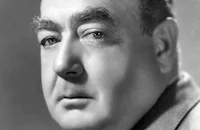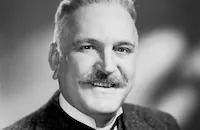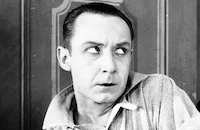The Half Naked Truth

Brief Synopsis
Cast & Crew
Gregory La Cava
Lupe Velez
Lee Tracy
Eugene Pallette
Frank Morgan
Shirley Chambers
Film Details
Technical Specs

Synopsis
To help Colonel Munday's ailing carnival, barker Jimmy Bates stages a scene with Teresita, an exotic dancer, in which he announces that the name of the local scoundrel who had deceived Teresita's mother years before is to be revealed during her next performance. After collecting "hush" money from various men in the town, Jimmy, Teresita and Achilles, an escape artist, are exposed as phonies by the sheriff. Having barely escaped arrest, the trio drives to New York, where Teresita, who is still dressed in her "harem" costume, attracts much attention. Inspired by the crowd's reaction, Jimmy announces the arrival of Princess Exotica from Turkey and tricks his way into a suite at the Savoy Ritz Hotel. There Jimmy plots publicity gimmicks to promote the "princess" and, with the help of a stunt airplane, a lion and thirty pounds of raw meat, finagles a generous contract for Teresita with Broadway producer Merle Farrell. When Teresita's austere Turkish dance number in Farrell's "Follies" show flops, however, Jimmy rushes onto the stage and improvises a little drama that segues into Teresita's performance of a jazzy carnival song. An overnight success, Teresita suddenly cools her relationship with Jimmy, who is on the verge of proposing to her, and makes plans with the married Farrell. Jealous but proud, Jimmy leaves Teresita and, after taking a compromising photograph of Farrell in Teresita's hotel room, hunts for a new "discovery." Jimmy introduces "Eve," a neophyte nudist, to the New York press, blackmails Farrell into signing her to a contract by plastering various enlargements of the compromising photograph all over Farrell's office, then establishes himself in his own publicity company. Without Teresita and Achilles, who has bought Munday's carnival, however, Jimmy becomes bored and irritable. Consequently, when Achilles wires him and begs for help, Jimmy quickly takes off for the carnival. There he discovers that Teresita, who had been fired from Farrell's show, is singing her carnival song and is waiting for him.

Director

Gregory La Cava
Cast

Lupe Velez

Lee Tracy

Eugene Pallette

Frank Morgan
Shirley Chambers

Franklin Pangborn
Robert Mckenzie
Mary Mason
James Donlan
Charles Dow Clark
Crew
Pandro S. Berman
Charles Burke
Carroll Clark
Bartlett Cormack
Corey Ford
Bert Glennon
Charles L. Kimball
Gregory La Cava
Ben Markson
Eddie Pyle
David O. Selznick
Oliver Sigurdson
Max Steiner
H. N. Swanson
John E. Tribby
Hugh Walker

Videos
Movie Clip




Hosted Intro
Film Details
Technical Specs

Articles
The Half-Naked Truth
That's the kind of craziness that stretches the boundaries of credulity. What's even crazier is that it's almost true. The Half Naked Truth is based, albeit loosely, on the shenanigans of real-life press agent Harry Reichenbach. In the course of his career - Reichenbach died in 1931, the year before The Half Naked Truth was released - Reichenbach worked for several studios and stars including Rudolph Valentino, Gloria Swanson, Charlie Chaplin, Ethel Barrymore, and Pola Negri. According to an article in a 1923 issue of Photoplay, he drew a salary of $1,000 a week - a princely sum at the time - for hatching ingenious publicity schemes for Broadway and Hollywood alike. For example, the lion stunt in The Half Naked Truth evolved from a campaign Reichenbach devised to promote the 1920 Revenge of Tarzan (also known as Return of Tarzan): He booked a room in a Manhattan hotel under the name "Thomas R. Zann," asking if pets were allowed. After being told the answer was yes, he arrived with a crate the size of a piano - and a piano is exactly what onlookers presumed was inside - and ordered it raised to the hotel-room window by a series of pulleys. Inside, of course, was a live lion. Reichenbach then proceeded to call room service to order a number of raw steaks for his "pet," which attracted the attention of the press, just as Reichenbach intended.
In another stunt reflected in the film, Reichenbach brought a half-dozen or so men masquerading as Turks to another tony Manhattan hotel. The men claimed they were looking for a missing woman known as the "Virgin of Stamboul," offering a $20,000 reward for her return. The whole thing, of course, was a scheme to advertise Tod Browning's 1920 Universal release The Virgin of Stamboul.
The Half Naked Truth captures the spirit of that freewheeling flim-flammery. By the time La Cava made the picture, he'd been working in Hollywood for nearly a decade. He'd begun his career as an animator, and was hired by William Randolph Hearst in 1915 to run International Film Service, a studio that would bring Hearst newspapers' comic strips to life on the movie screen. After the dissolution of the studio, La Cava headed for Hollywood, where he began directing live-action two-reelers. Though La Cava's biggest successes would come later in the 1930s, with pictures like My Man Godfrey (1936) and Stage Door (1937), The Half Naked Truth shows sparks of the verve and wit that La Cava would later perfect. Upon its release, New York Times reviewer Mordaunt Hall seemed delighted with the film, claiming that it delivered "salvos of good fun," though he did say it might be better if it hewed more closely to the book that inspired it, Phantom Fame, co-written by Reichenbach and David Freedman.
But for the most part, Hall's enthusiasm wasn't terrifically off base: As Reichenbach's fictional doppelganger Jimmy Bates, Lee Tracy gives a rakish, free-spirited performance. His loose-limbed physicality, in particular, is something to behold - his bones seem to be connected by springs. And his banter with the sultry-funny Velez - who spends much of the movie clad in filmy veils and skimpy bandeaux -- is wonderful, and frequently rather naughty. (Of particular interest is Velez's saucy musical number, a song about looking for a carpenter to fix, among other things, her non-functioning doorbell.) Frank Morgan plays a lascivious Broadway producer who gets caught in a rather compromising position with Teresita, who becomes his protégée (and more). The always-wonderful Eugene Pallette also appears, looking particularly fetching when disguised as a Turk, his fez perched rakishly across his bushy, perpetually annoyed eyebrows. The Half Naked Truth also holds the distinction of featuring the only screen appearance of Max Steiner, who also composed the music for the film: Look for him in a brief appearance as a bandleader.
Producers: Pandro S. Berman, David O. Selznick
Director: Gregory La Cava
Screenplay: Screenplay by Gregory La Cava and Corey Ford. From a story by Ben Markson and H. N. Swanson. Suggested by Phantom Fame, by Harry Reichenbach and David Freedman.
Cinematography: Bert Glennon
Music: Max Steiner
Film Editing: Charles L. Kimball
Cast: Lupe Velez (Teresita), Lee Tracy (Jimmy Bates), Eugene Pallette (Achilles), Frank Morgan (Farrell), Shirley Chambers (Gladys)
By Stephanie Zacharek
SOURCES:
The New York Times
IMDb
JTA Achive (http://www.jta.org/jta-archive/archive-page)
Michelle Vogel, Lupe Velez: The Life and Career of Hollywood's Mexican Spitfire
Photoplay, August 1923

The Half-Naked Truth
The Half Naked Truth on DVD
This fast-moving, often hilarious pre-Code comedy is the earliest of three Lee Tracy films recently issued on DVD by Warner Archive. (See separate reviews of Turn Back the Clock [1933] and The Nuisance [1933]). It's also one of Tracy's all-time best roles. The script calls for his character to make things happen by sheer impudence and audacity -- to make things up to the press in order to generate publicity and transform his fortunes. And Tracy, with a screen persona as a fast-talking, fast-thinking, impulsive firebrand, makes us believe he can do it.
At the beginning of the picture, Tracy is working in the carnival racket. When one of his fake acts gets exposed, he hightails it out of there with dancer Lupe Velez and his assistant Eugene Pallette, telling them, "Next stop, Broadway!"
Cut to Broadway, where Tracy instantly declares Velez to be a Turkish princess, building interest from reporters and scoring a fancy hotel room from hotel manager Franklin Pangborn. When Pangborn asks about Pallette, Tracy explains that he is the princess's eunuch! ("Every Turkish harem has one. They're very expensive.") Even for a pre-Code movie, it's amazing that this racy, running gag somehow stayed in the film. Eventually, Tracy latches on to Broadway producer Frank Morgan (superb), and cleverly gets Morgan to want to sign the "princess." And when Morgan and Velez start a romance and turn Tracy away, he is so infuriated that he plucks Morgan's secretary and turns her into a star -- by fabricating a nudist colony and leaking to the press that she hangs out there. To ensure front-page coverage, Tracy arranges for a carful of nudists -- including the secretary and Eugene Pallette (!) -- to be arrested in broad daylight on Fifth Avenue, in a sequence shot on location.
These are just a few of the outrageous publicity gimmicks that Tracy's press agent comes up with here. Through it all, The Half Naked Truth holds up well because its satire of the publicity business -- where it's easy to become famous for nothing, and to be famous for being famous -- is still so very relevant today.
It's also just plain funny, whether it's showing Pallette "rehearsing" love scenes with the attractive secretary, over and over, or -- in a spectacular centerpiece -- showing Lupe Velez bringing the Broadway house down with an amazingly energetic, infectious dance sequence that director Gregory La Cava smartly allows to last a good long while.
La Cava was an important veteran director of silent films and talkie screwball comedies who would soon direct She Married Her Boss (1935), My Man Godfrey (1936) and Stage Door (1937). While The Half Naked Truth runs a little bit out of steam as it winds down, it is perhaps La Cava's most significant earlier sound effort and is well worth catching. It's also worthwhile for Lee Tracy, a truly under-remembered star who deserves to be better known. Warner Archive's DVD is a typical no-frills affair, and has not been remastered, but still looks and sounds perfectly acceptable.
By Jeremy Arnold
The Half Naked Truth on DVD
Quotes
Trivia
Notes
The Anatomy of Ballyhoo was an account detailing the exploits of late press agent Harry Reichenbach. The working title of this film was Phantom Fame. According to reviews, Bartlett Cormack was a co-screenwriter on the production. His name, however, was apparently removed from the final film credits. According to a Film Daily news item, Jay Eaton and Hal Crane were cast members, but their participation in the final film has not been confirmed. An early draft of the film's screenplay elicited many censorship suggestions from Jason S. Joy of the MPAA, who wrote to producer David Selznick in September 1932. According to Joy's letter, the lines, "I'll spank your bottom," "There used to be, but it went Republican," "I ain't got that far with her yet," "I will not turn my tail and run" and "Plant these where they will do the most good," were questionable, as were the words "eunuch" and "punk." In addition to many other suggestions, Joy recommended that "the nudist business" be shot in a way as to assure "no exposure" or views of leering faces. Most of Joy's suggestions were taken by Selznick, and very few of the "objectionable" lines or bits were left in the script. According to RKO production records, during filming, actor Lee Tracy provoked the ire of Selznick because of his repeated late arrivals and absences from the set. In a "strictly confidential" October 8, 1932 inter-office memo, Selznick recommended that, "for the good of the company and the industry," a legal suit be brought against Tracy for the total amount of monies he had cost the studio. Selznick suggested serving Tracy with the lawsuit "on the set as soon as the last scene has been finished, and in front of the entire company." As threatened, RKO withheld $3,500 from Tracy's final paycheck and then filed a $10,000 "conciliation" suit against him through the Conciliation Committee of the Academy of Motion Pictures Arts and Sciences on October 14, 1932. Dr. Frederic Bergstrom, speaking to the press on behalf of Tracy, stated that Tracy was suffering from a nervous breakdown and that his set absences had been the result of stomach disorders. In spite of Selznick's stated desire to run Tracy "out of the industry," RKO finally settled the suit out of court. By agreement, RKO paid Tracy $1,500, half of his withheld salary, and promised that, if he behaved himself during production, he would be rewarded with the other half as a bonus upon completion of his next RKO movie. In October 1936, Tracy completed filming on Wanted! Jane Turner and requested his promised bonus.















